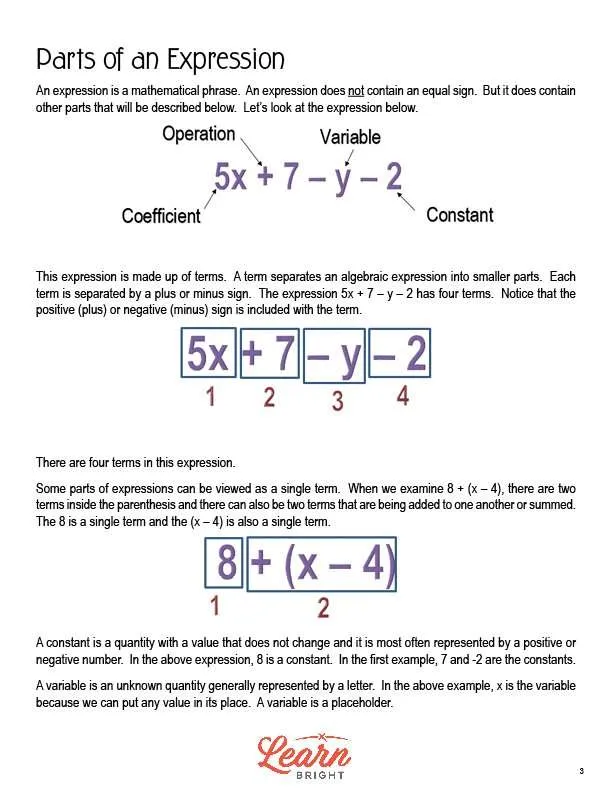Description
What our Parts of Algebraic Expressions lesson plan includes
Lesson Objectives and Overview: Parts of Algebraic Expressions introduces students to algebraic expressions, which are any mathematical calculation combining numbers and variables, their parts, and how to use them. At the end of the lesson, students will be able to identify parts of an expression. This lesson is for students in 6th grade.
Classroom Procedure
Every lesson plan provides you with a classroom procedure page that outlines a step-by-step guide to follow. You do not have to follow the guide exactly. The guide helps you organize the lesson and details when to hand out worksheets. It also lists information in the blue box that you might find useful. You will find the lesson objectives, state standards, and number of class sessions the lesson should take to complete in this area. In addition, it describes the supplies you will need as well as what and how you need to prepare beforehand.
Options for Lesson
Included with this lesson is an “Options for Lesson” section that lists a number of suggestions for activities to add to the lesson or substitutions for the ones already in the lesson. One optional addition to the lesson activity is to increase the number of ‘corners’ in the room by adding a section for more of the vocabulary terms such as exponent, sum, difference, product, and quotient. For an additional activity, you could have students make posters of each part of an expression in groups and hang the posters around the classroom. Finally, you could have students make a foldable for remembering each of the vocabulary terms.
Teacher Notes
The teacher notes page includes lines that you can use to add your own notes as you’re preparing for this lesson.
PARTS OF ALGEBRAIC EXPRESSIONS LESSON PLAN CONTENT PAGES
Parts of an Expression
The Parts of Algebraic Expressions lesson plan includes two content pages. Expressions are mathematical phrases. They do not contain an equal sign, but do contain other parts.
Let’s look at the expression 5x + 7 – y – 2. In this expression, 5x is a coefficient, + is an operation, y is a variable, and 2 is a constant.
Expressions are made up of terms. Terms separate algebraic expressions into smaller parts, and each term is separated by a plus or minus sign. The expression 5x + 7 – y – 2 has four terms. Each term includes the positive (+) or negative (-) sign. The four terms are: 5x, + 7, – y, and – 2.
Some parts of expressions are considered a single term. Let’s look at 8 + (x – 4). This expression includes two terms inside the parenthesis. 8 is a single term, as is (x – 4).
Constants are quantities that have values that do not change, often represented by a positive or negative number. In the expression 8 + (x – 4), 8 is a constant. In the earlier example, 7 and -2 are constants.
Variables are unknown quantities, usually represented by a letter. In the earlier example, x is the variable. You can put any value in its place. Variables are placeholders.
Coefficients are the numeral parts attached to variables. When coefficients and variables are next to each other, it represents multiplication. Variables always have coefficients. The variable x has a coefficient of 1 and -x has a coefficient of -1.
Vocabulary and Examples
The lesson includes a list of vocabulary words and their definitions. The lesson includes an example for each vocabulary word.
An expression is any mathematical calculation combining numbers and variables using operations. They do not have an equal sign. An example of an expression is 2 + 4y + 8x – 9.
A term is each part separated by plus or minus signs in an algebraic expression. An example of a term is + 4y for the expression 2 + 4y + 8x – 9.
A coefficient is the numerical part of a term that contains a variable. An example of a coefficient is the 6 in 6x.
A variable is a placeholder for any value. An example of a variable is x or y.
A constant is a term without a variable. An example of a constant is 7.
The lesson closes with examples of different types of expressions. An example of the product of two terms is 4x(6y + 3). An example of the difference of two terms is 3x – 4y. Next, an example of the sum of two terms is (x – 9) + y. Finally, an example of the quotient of two terms is 18 ÷ 5x.
PARTS OF ALGEBRAIC EXPRESSIONS LESSON PLAN WORKSHEETS
The Parts of Algebraic Expressions lesson plan includes four worksheets: an activity worksheet, a practice worksheet, a homework assignment, and a quiz. You can refer to the guide on the classroom procedure page to determine when to hand out each worksheet.
FOUR CORNERS ACTIVITY WORKSHEET
The activity worksheet asks students to participate in an “Identify parts of an Expression” four corners activity. Each corner of the room will be labeled with constant, term, coefficient, and variable. Each student receives a card with a component of an expression and will go to the corner represented on their card when the teacher says ‘Go!’. The students will then check to make sure that everyone in the group should be in that corner. They will change cards after each problem.
IDENTIFY PRACTICE WORKSHEET
For the practice worksheet, students will identify the different parts of expressions by circling them using different colored markers. They will also identify which operation is occurring between two terms in various expressions. Finally, they will answer a few written questions about the lesson material.
PARTS OF ALGEBRAIC EXPRESSIONS HOMEWORK ASSIGNMENT
The homework assignment asks students to fill in the table for each expression. For each expression, they will identify the total number of terms, the constants, the variables, and the coefficients. They will then match expressions with the correct operations.
QUIZ
This lesson also includes a quiz that you can use to test students’ understanding of the lesson material. For the quiz, students will look at an expression and put a square around the constants, circle the coefficients, highlight the operations, and underline the variables.
Worksheet Answer Keys
This lesson plan includes answer keys for the practice worksheet, the homework assignment, and the quiz. If you choose to administer the lesson pages to your students via PDF, you will need to save a new file that omits these pages. Otherwise, you can simply print out the applicable pages and keep these as reference for yourself when grading assignments.









